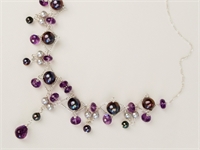
Chocolate Pearls
Important Notice: Our web hosting provider recently started charging us for additional visits, which was unexpected. In response, we're seeking donations. Depending on the situation, we may explore different monetization options for our Community and Expert Contributors. It's crucial to provide more returns for their expertise and offer more Expert Validated Answers or AI Validated Answers. Learn more about our hosting issue here.
Pearls—Classic Gemstones
Man has long been fascinated by pearls. Over the centuries, pearls have become a valuable commodity, sought for their exquisite shapes and lustrous colors. Pearls are gemstones and come in many varieties; each type of pearl has its own distinct characteristics. There are several varieties of pearls to be found all over the world, produced by various types of oysters (shelled mollusks) that live in salt or fresh water. One of the most prized and rarest types of pearl is the Tahitian pearl.
Location of Tahitian PearlFarms
Tahitian pearls are produced on pearl farms and come from the Tuamotu Archipelago island chain in French Polynesia, an area populated by small islands and atolls. This archipelago is located west of Tahiti, in the South Pacific Ocean, just to the east of Australia. The center of the Tahitian pearl trade is found on the atoll of Hikueru, near the center of the Tuamotu island chain.
The Black-Lipped Oyster
The area around Hikueru is the natural breeding ground for the Pinctada Margaritifera Cumingi, also known as the black-lipped oyster. This oyster is responsible for the production of Tahitian pearls, and is very large and able to grow to a length of 12 inches. The shelled mollusk has a lifespan of up to 30 years in nature, and often weighs up to 1 pound. The oyster becomes a pearl-producer between the ages of 3 to 7 years. Black-lipped oyesters produce a dark colored pigment which produces black pearls, known as Tahitian black pearls. These pearls are not actually black, but are often grey, silver and charcoal colored. Pure black pearls are rare. Most black pearls are color-enhanced to produce the dark colors. The black-lipped oyster also produces Tahitian chocolate pearls.
Tahitian Chocolate Pearls
The black-lipped oyster is also responsibility for producing Tahitian chocolate pearls. Chocolate pearls are also dark, but obtain a more brownish coloration, varying from shades of copper, bronze and rust-brown to chocolate brown. Chocolate pearls can also be the product of the color-enhanced process, but it is possible to find naturally brown pearls, though they are rare. Tahitian brown pearls are quite sought after, and are very expensive. The color-enhanced brown pearls are considered to be of a lower quality and are available at lower prices than natural Tahitian chocolate pearls. Natural Tahitian chocolate brown pearls are very rare, and therefore are in the highest quality classification, with higher prices reflecting their rarity. Chocolate brown cultured pearls are also beautiful, but are easier to find and are more reasonably priced than naturally produced pearls.
Pearls Make Wonderful Gifts
Pearls add a classic, beautiful touch to an outfit, and can be worn with everything from formal dresses to jean. Tahitian chocolate pearls make exotic and stunning jewelry pieces, and are perfect to wear for all occasions. These pearls are often made into chocolate pearl necklaces, chocolate pearl bracelets, chocolate pearl earrings, and chocolate pearl rings. These exquisite pieces of jewelry make lovely gifts for women of all ages, for all gift-giving occasions such as Christmas, birthdays, Valentine’s Day, and more.
Proper Care of Tahitian Chocolate Pearls
Pearls are very durable, yet fragile gemstones, and need to be handled, cleaned and stored in the proper way in order to preserve their beauty. To care for your Tahitian brown pearls, follow these steps:
Where to buy Tahitian Chocolate Pearls
Tahitian pearls can be found at many fine jewelers’ showrooms. If you are purchasing your pearls over the Internet, be sure to read the description of the pearls to understand exactly what you’re buying. If you buy directly from a jeweler, be certain to ask questions to determine the quality of the pearls, where they were produced, and if they have been color-enhanced. Economic chocolate pearls are color-enhanced and are considered to be of a lesser quality than natural chocolate pearls, though they are both beautiful. Look for shops that are affiliated with the Gemological Institute of American (GIA) and the Cultured Pearl Association of America. These organizations help to establish international guidelines for pearl quality around the world. If you buy your pearls from a shop registered with one of these organizations, you can be sure you are buying quality Tahitian pearl jewelry.
Tahitian chocolate pearl jewelry—necklaces, bracelets, rings, and earrings—make the perfect gift for any occasion. Chocolate pearls are perfect to wear for any occasion, and make a wonderful, lasting gift that will be appreciated for years to come.